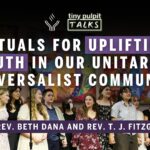Luminaries of Truth and Justice: Leading with Love | Rev. Beth Dana | 09.22.2024
Sermon Transcript:
It was 1848 in Rochester, New York. Maria Weston Chapman stood before the Women’s Rights Convention at the Unitarian Church there to give a talk entitled The Times That Try Men’s Souls, echoing the words of founding father, Thomas Paine, who wrote in the American crisis that the colonists were living in a period that would force them to show their true character. And in fact, this was another moment in history when people were forced to show their true character. Chapman was part of a wealthy Boston Unitarian family, a member of William Ellery Channing’s Federal Street Church, and immersed in a society fueled and funded by slave trade wealth. And yet her family had taken a bold abolitionist stance. She was a socialite, well-dressed and quaffed, and as such, was often suspected of being a spy when she showed up at meetings of radical activists. She stood before this Women’s Rights Convention and said this, “Confusion has seized us and all things go wrong. The women have leaped from their spheres and instead of fixed stars, shoot as comets along and are setting the world by the ears. In courses erratic, they are wheeling through space in brainless confusion and meaningless chase. In vain do our knowing ones try to compute their return to the orbit designed they’re glanced at a moment then onward they shoot and are neither to hold, nor to bind. So freely they move in their chosen ellipse, the lords of creation do fear and eclipse. They’ve taken a notion to speak for themselves and are wielding the tongue and the pen. They’ve mounted the rostrum, the termagant elves and oh horrid, are talking to men.”
I love the sarcastic humor of Maria Weston Chapman. The termagants, a term that was new to me, meaning harsh-tempered and overbearing women, are leaping from their spheres, and such is the history of women leaders, both laypeople and clergy in our Unitarian Universalist tradition. We’ve been on the forefront and pushed boundaries in many ways and today I want to share with you the inspiring stories of some of these women. Women who, like in our story this morning, listened to that strong inner guiding sense of right and wrong, of truth and justice. They were also keenly aware of the disparity between the spheres where society said they belonged and where they knew they actually belonged. I want you to think for a moment, have you ever been told either explicitly or implicitly that you don’t belong somewhere? What did that feel like? What did you do?
I still remember viscerally an experience that I had nearly 20 years ago, the first time that I ever showed up in an intentionally queer space, a space intended as a safe space for LGBTQ folks. It was a bold move for me at the time. And when I walked into the room, someone I knew and who knew me said, “What are you doing here?” And I paused, that feeling of being called out hit my gut, and I probably didn’t say anything terribly articulate, but what I wish I’d said is something like, “I’m here and I’m queer and I belong here.”
Think about this as we explore the stories of Unitarian and Universalist women in our history who made bold, courageous moves out of the acceptable spheres of womanhood and know that many bold, courageous people, their descendants, are among us here. One of the challenges that has persisted for women for hundreds of years is the struggle between the expectations and demands of women in the sphere of home and family and the call of conscience toward leadership, activism, ministry, and other work in spheres beyond the home. Still today, there’s conversation about the women who do it all and the women who make the choice to stay home with kids or women who devote their lives to service in many forms and choose not to have children with judgments coming from every direction about what’s right and good. We’ve come a long way, but we’re still wrestling with the spheres that women occupy.
A group of Unitarian ministers in the Midwest during the late 18 hundreds and early 19 hundreds called the Iowa Sisterhood allied themselves with this idea of the women’s sphere being the home, while also redefining what ministry could look like, with the congregation as the home or the hearth, their ministry extending to the larger society to make a better home for the human family and the relationship of colleagues being one of sisterhood. Women ministers like Marion Murdoch and Florence Buck, who were both life partners and partners in ministry, served Unitarian churches together as co-pastors and were active in movements for women’s suffrage and women in ministry. Marion went so far as to say that ministry is one of the most appropriate professions for women, and as you can imagine, she had a few people who disagreed with her.
Mary Augusta Safford, the author of our reading today, was a Unitarian minister in the Midwest who planted and grew churches throughout that area, and mentored numerous young women into ministry. She was born and raised on the banks of the Mississippi River and began her preaching career as a little girl from a tree stump pulpit on her family’s farm. Her mother assumed that she would take her rightful place working for the church in the kitchen and praying in the pews, but Mary had other plans. Her father’s early death and her discovery of his library, which contained shocking new ideas like biblical fallibility, the abolition of slavery and the theory of evolution drew her into a different sphere. She had a heavenly vision that depended on the church to give of itself, to be a beacon light to storm-tossed souls, to be loyal to the truth it sees bravely stand by its convictions and work for the human good. In addition to being a minister, Safford was a poet and a hymn writer. In one hymn, she wrote about the church, “We pray that it may ever be a home for all who seek for thee, the home of faith in all things true, a faith that seeks the larger view, the home of love that yearns to bless, the home of truth and righteousness. Long may it stand, the outward sign of that indwelling life divine.”
The Iowa sisterhood was, according to historian, Cynthia Grant Tucker, at once, influential and impotent, conspicuous and invisible, highly vocal and effectively silenced. The way that they blended the spheres of home and ministry felt threatening to male ministers at the time, many of whom sought to shut down the ministries of these women in order to return to a manlier ministry. Mary Safford’s response was, “Strong men are not afraid to work with women ministers.” I think she would be thrilled to see clergy teams like ours today over a hundred years later. The women of the Iowa Sisterhood were not the only Unitarian and Universalist women claiming their place in the sphere of ministry and leadership in that time. There were women like Olympia Brown, the first woman to achieve full ministerial standing recognized by a denomination in the United States when she was ordained as a Universalist minister in the year 1863, she fought hard to get there.
In college, a professor told her that she wasn’t expected to remember everything she was taught, only enough to hold intelligent conversation. And in classes where only men were expected to memorize speeches, she recited every one of hers from memory. She felt called to ministry. But when she applied to seminary, she received a reply from the president of the seminary saying that he didn’t think women should be ministers, but that he would leave that between her and the great head of the church, meaning God. So she showed up at seminary, much to the surprise of the administration. They had not expected her to come. She was the only female student on campus, mocked by male students and given the cold shoulder by faculty wives. Her ordination too was bitterly contested with male ministers arguing that it would bring down the price of preaching.
She was only allowed to serve declining churches, what she referred to as comatose churches, but she breathed life back into them and lifted up women in leadership. As she traveled around the country speaking in support of women’s suffrage and women’s rights, she had rocks and debris thrown at her. At every turn, she got the message, “You don’t belong here, stay in your sphere.” Like the termagant’s of Maria Chapman’s speech, she leapt from her sphere again and again and again. In addition to trailblazing women ministers, there were also powerful laywomen like Frances Ellen Watkins Harper, who was born into a free Black family in 1825. She traveled around the country giving lectures about freedom for women, particularly Black women, to be more than wives and mothers and to be seen and treated as whole human beings. She knew what it meant to be a whole and engaged person and a mother.
After her husband died, she took her daughter with her on lecture tours. She found in the Unitarian Church a place where people of different races met and worshiped together, and a place that expanded her sphere of influence and opportunity to reach more people. As a widow, she earned her own money, most of which she chose to donate to abolitionist causes. William Still, a leader in the Underground Railroad in Philadelphia, once told her to keep more of her money for her herself. And her response was, “Let me explain a few matters to you. In the first place, I am able to give something. In the second place, I am willing to do so.” In a society and in a time when many did not embrace her humanity, she insisted on recognizing and uplifting the full humanity of others because as she said in a famous speech, “We are all bound up together in one great bundle of humanity and society cannot trample on the weakest and feeblest of its members without receiving the curse in its own soul.”
Maria Weston Chapman, Marion Murdoch, Florence Buck, Mary Safford, Olympia Brown, Frances Ellen Watkins Harper, and so, so many more, these are our foremothers. They inspire me as luminaries of truth, justice, courage, and resilience. And whether we’re aware of it or not, they really helped create the foundation for the work that we have done as First Unitarian Church of Dallas. We too have a history of powerful women’s leadership. Our Women’s Alliance has been around almost as long as the congregation itself. Its members have sustained our church through hard times, continue to contribute to our congregation and wider community in generous and impactful ways, and have been involved in groundbreaking initiatives that have widened the sphere of women in our church and at the national and even international level. There have been women like Louise Raggio, who Daniel spoke about in last week’s sermon, known as the Mother of Texas family Law.
There have been women like Rita Taubenfeld who sat right about there for years. She was a political economist with a commitment to international women’s rights, who attended the 1975 United Nations International Women’s Year Conference in Mexico City, and was instrumental in passing resolutions, both at that conference and in our Unitarian Universalist Association, calling on us to examine the religious roots of sexism in our traditions and to address the oppression of women around the world. All of this paved the way for women in ministry to assume more positions of power, including women like Reverend Laurel Hallman. In 1987, this church called her as its first female senior minister. At the time, there were very few women ministers serving large churches like this one. Her ministry continued to grow the church in size, in generosity, and in spiritual depth. And it was during Reverend Hallman’s ministry that this church really took on the work of being a welcoming congregation for LGBTQ plus people.
And we continue to be a community committed to gender equity for women and for all people whose gender identity is marginalized due to patriarchy and transphobia. And of course, there is the movement that we continue to build on today for reproductive rights and dignity. In a society that’s still in a different way than in the 18 hundreds, but still reinforces that women’s sphere is the home and motherhood, we steadfastly insist that people must have the right to make choices about their own bodies. In the 1970s, the Women’s Alliance of this church, after a year of study and dialogue on abortion, joined a broad coalition in Dallas that provided political, financial, and personal support to those organizing to make abortion legal, including attorney Sarah Weddington, who successfully argued the Roe V. Wade case before the US Supreme Court. The founding of the Truth Pregnancy Resource Center this year, and the sacred designation that we received today for our work on reproductive dignity are just some of the ways that we continue to carry out this commitment as a church.
Today, our church includes women who move and lead in all spheres of our society. While we are still fighting the 2024 version of many of the same fights that our foremothers faced, we are less on the margins than we once were. At every time in history, there have been those who were at the center of power and those who were on the margins, the rebels and radicals and luminaries of truth and justice. It’s a dynamic that Black feminist scholar, Bell Hooks, has written quite a bit about. As she explains it, “For every group there is a center and a margin where the center has more power, influence, or control. People on the margin can only move so close to the center before those in the center retake power. Often being in the center is an unearned privilege based on one’s race, class, or gender. And while people most often advocate for the people who are on the margins to make efforts to move toward the center, these efforts,” she says, “are rarely successful without the people at the center moving out or decentering themselves. Without the decentering of those in power, the power structures that have been built around them will push back on the margins every effort to bring about change.”
This is what was happening with the Iowa Sisterhood. They were on the Midwest frontier margins. A group of women trying to reshape the way we do church and grow the movement of Unitarian churches in parts of the country that needed our message and our ministry. The American Unitarian Association in Boston resisted their efforts, trying to maintain the center of power and the usual ways of doing things. But the Iowa Sisterhood had an ally in a man named Jenkin Lloyd-Jones, leader of the Western Unitarian Conference, a person in power who supported their work. And this is where all of us come in. This doesn’t just apply to power dynamics of gender, but think about any of the communities or institutions that you are a part of. Perhaps you are at the center of power in some of them. What are you hearing from those on the margins?
How are they calling for change? And in what ways are they being barred from contributing? And perhaps in another context, you are on the margins. Have any of you ever been on the margins fighting for change and feeling defeated? Yeah. Who are your allies in power that could help to shift the dynamic by de-centering themselves and creating space for change? Wherever you are in the power structures of your life, you can bring about change. Radicals don’t only exist on the margins. Sometimes those at the center become radicals because of the risks that they take and the ways that they lift up the leadership of those who are on the margins of society. So let’s embrace the call of Mary Safford that began our reading today, which said, “We must realize our debt to the past, a debt that we cannot pay save by being brave and true and helpful in the present.” So be brave, my friends. We have many examples from our past and present to give us courage. Be true, follow your conscience and be helpful, giving what you have to give for the larger. May it ever be so. And amen.








